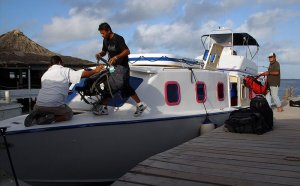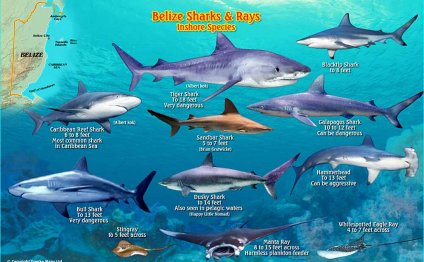
Belize water Hole
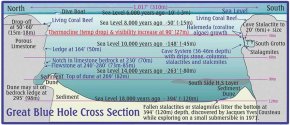 A feature attraction of Diving in Belize, Especially for divers with a appreciation of geographical phenomena, is the opportunity to explore the famed Blue Hole. Part of the Lighthouse Reef System, it lies approximately 60 miles off the mainland out of Belize City. It is one of the most astounding dive sites to be found anywhere on earth, right in the center of Lighthouse Reef is a large, almost perfectly circular hole approximately one quarter of a mile (.4 km) across. Inside this hole the water is 480 feet (145 m) deep and it is the depth of water which gives the deep blue color that causes such structures throughout the world to be known as "blue holes."
A feature attraction of Diving in Belize, Especially for divers with a appreciation of geographical phenomena, is the opportunity to explore the famed Blue Hole. Part of the Lighthouse Reef System, it lies approximately 60 miles off the mainland out of Belize City. It is one of the most astounding dive sites to be found anywhere on earth, right in the center of Lighthouse Reef is a large, almost perfectly circular hole approximately one quarter of a mile (.4 km) across. Inside this hole the water is 480 feet (145 m) deep and it is the depth of water which gives the deep blue color that causes such structures throughout the world to be known as "blue holes."
Like a giant pupil in a sea of turquoise, The Blue Hole is a perfectly circular limestone sinkhole more than 300 feet across and 412 feet deep. The array of bizarre stalactites and limestone formations which mould its walls seem to become more intricate and intense the deeper one dives. Near to The Blue Hole, one of Belize's largest protected areas, Half Moon Caye Natural Monument, encompasses 10, 000 acres of the atoll and 15 square miles of surrounding waters.
The diameter of the circular reef area stretches for about 1, 000 feet and provides an ideal habitat for corals to attach and flourish. The coral actually breaks the surface in many sections at low tide. Except for two narrow channels, the reef surrounds the hole. The hole itself is the opening to a system of caves and passageway that penetrate this undersea mountain. In various places, massive limestone stalactites hang down from what was once the ceiling of air-filled caves before the end of the last Ice Age. When the ice melted the sea level rose, flooding the caves. The temperature in the Blue Hole at 130ft is about 76F with hardly any change throughout the year at that depth.
The temperature in the Blue Hole at 130ft is about 76F with hardly any change throughout the year at that depth.
For all the practical purposes the over 400-foot depth makes the Blue Hole a bottomless pit. The walls are sheer from the surface until a depth of approximately 110 feet where you will begin to encounter stalactite formtions which actually angle back, allowing you to dive underneath monstrous overhangs. Hovering amongst the stalactites, you can't help but feel humbled by the knowledge that the massive formation before you once stood high and dry above the surface of the sea eons ago. The feeling is enhanced by the dizzying effect of nitrogen breathed at depths. The water is motionless and the visibility often approaches 200 feet as you break a very noticeable thermocline.
In the deeper waters of the Blue Hole itself, you might see a curious blacktip tiger or hammerhead shark, but on most dives you won't see anyone except your dive buddy. Little light reaches the depths of the Hole and water does not circulate freely. As a result, the deeper areas inside the Blue Hole don't have the profusion of life associated with most drop-offs. But as you venture into the shallows around the rim of the Blue Hole to off-gas after your dive, you will discover a wonderful area filled with life.
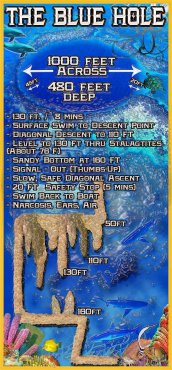 Pederson's cleaning shrimp are everywhere inhabiting the ringed and knobby anemones. With the frantic waving of their antennae, these shrimp invite you, along with passing fishes, to be cleaned. Neon gobies also advertise their cleaning setvices from the various coral heads. Angelfish, butterflyfish hamnlets and small groupers are also commonly seen. Elkhorn coral grows to the surface and purple seafans, resplendent of their rich hues, sweep at the calm surface waters. If you look up, you will double your pleasure as you catch the reflections of sea fans in the aquamarine mirror of the calm water.
Pederson's cleaning shrimp are everywhere inhabiting the ringed and knobby anemones. With the frantic waving of their antennae, these shrimp invite you, along with passing fishes, to be cleaned. Neon gobies also advertise their cleaning setvices from the various coral heads. Angelfish, butterflyfish hamnlets and small groupers are also commonly seen. Elkhorn coral grows to the surface and purple seafans, resplendent of their rich hues, sweep at the calm surface waters. If you look up, you will double your pleasure as you catch the reflections of sea fans in the aquamarine mirror of the calm water.
Dive boats leave very early in the morning - most guides bring sweet buns for those who can't find any place to eat in the early moring hours. Bring your own coffee, however.
One can get mildly narked in back-set caves 150' down in clear, still water, filled with 25 to 50 foot long stalactites.
Guides pole the group and chum in sharks on a majority vote. Bull, Reef and Hammer Head sharks found here, that look enormous, even from behind the protection of a handy stalagmite.
A rare - wonderful dive. However this is truly a techical category decompression dive, not recommended for newbys or resort dive qualified divers. (The bottom of Blue Hole is over 400 feet down and the wall slopes back, such that one must have absolute buoyancy control rather than to depend on something to grasp if starting to plummet while descending. Likewise - ballooning is equally deadly to ones health when coming up from 150 plus feet and requires excellent buoyancy control. Decompression times are around 10 to 15 minutes at 20 feet.). The best dive guides anchor a spare tank and regulator at your 20 foot deco spot, usually at the permanent mooring anchor located around the rim of the Blue Hole, which your boat moors too.
©1992-2013 purchase this item @ - All Rights Reserved.
RELATED VIDEO

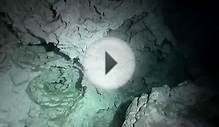
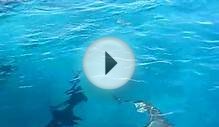
Share this Post
Related posts
San Pedro Belize Water taxi
Visitors to the Caye can also take a water taxi or ferry from Belize City to San Pedro. The trip, mostly on fast open boats…
Read MoreCaye Chapel, Belize
The Caye Chapel Island Resort, described by sales agents as “the ultimate private retreat” and “a true trophy property, ”…
Read More
